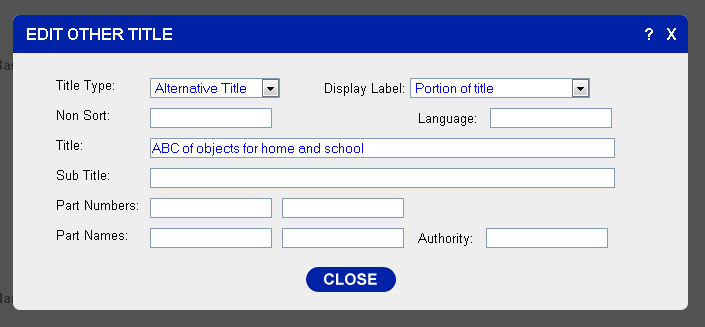
Miskatoniciensis


Other Titles Element HelpDefinitionOther Titles refers to title information after the title proper; including Series Titles, Translated Titles, Alternative Titles, and Uniform titles. The title is a word, phrase, character, or group of characters, normally appearing in a resource, that names it or the work contained in it. 1 The entire title field consists of the title and may also contain the general material designation (medium), remainder of title, other title information, the remainder of the title page transcription, and statement(s) of responsibility. The title proper includes the short title and alternative title, the numerical designation of a part/section and the name of a part/section. For mixed material, the title statement is defined as the name by which the material is known. 2 In addition, the following subelements exist for any additional title to associate with material:
Finally, a title type is included for titles which are not the main title. The table below explains the differences between each title type:
Form ElementIn the online templates, this element appears as below:  Upon clicking or typing in the main box, the form below appears to give access to all the individual components of the other titles element:  This form element allows the user to enter just the simple title text for an alternative title, abbreviated title, series title, uniform title, or translated title. The non-sort element of the title (leading article or punctuation) should be included. Other form elements for entering title information include Main Title and Complex Title Entry. A title used as a subject should be entered through one of the subject form elements. Best PracticesNot all items will require Other Titles, but the Other Title field is repeatable. Title: All items should include information in the Title field, and Non Sort terms should be entered in the Non Sort field. Title information may come from the cover or title page of a book or document or may come from a description of a map or image. The origin of title information may be noted in the Note field, for example, “Title information from cover page”. Example: The Americans in Panama Subtitle: Not all items will have a subtitle. Information that appears in a title after a colon, or appears after the title on the title page but not on the cover or half title page, should be included as a subtitle. Example: The Aftermath of the Trujillo dictatorship: the emergence of a pluralist political system... Part Number: Not all items will have a Part Number. The part number should be included on the title page of an item. Example: Saint Nicholas: Volume 9, no. 12. October 1882. Part Name: Not all items will have a Part Name. The part name should be included on the title page of an item. Example: pending Statement of Responsibility: Some items will not have a statement of responsibility. If phrases such as “by” or “edited by” or “by the author of” appear on the item, this information should be included in the Statement of Responsibility. Example: Jack and Florie, or, The Pigeons' wedding Language: Languages should be entered either by the ISO code, or by the term from the MARC Code List of Languages. Example: pending Authorities: The name of the authoritative list for a controlled value is recorded here. An authority attribute may be used to indicate that a title is controlled by a record in an authority file (e.g. authority="naf"). A list of authority files is maintained at: www.loc.gov/marc/sourcecode/authorityfile/authorityfilesource.html. Title authorities can also be accessed at http://authorities.loc.gov/cgi-bin/Pwebrecon.cgi?DB=local&PAGE=First . Example: pending Title Type:Select the title type most appropriate. Below are some additional considerations by other title type:
In the actual MODS metadata, the series title is implemented a little bit differently, being mapped into a title field under a related item field with type equaling series. Sources
ContributorsNicola Hill, Mark Sullivan, and Laurie Taylor |